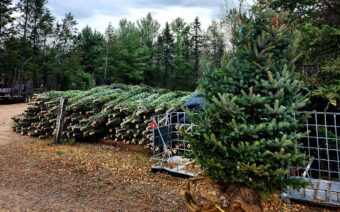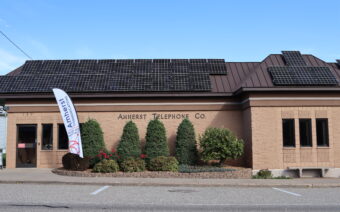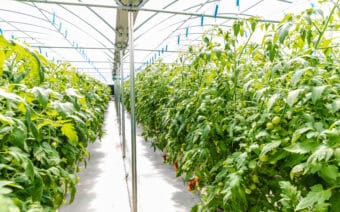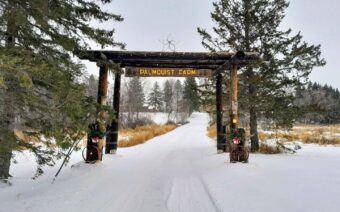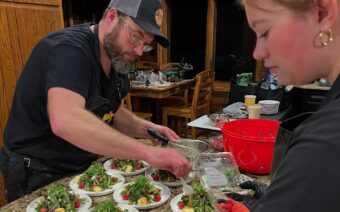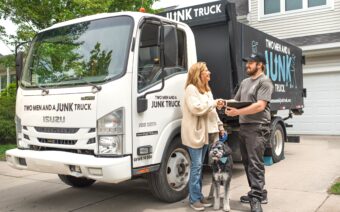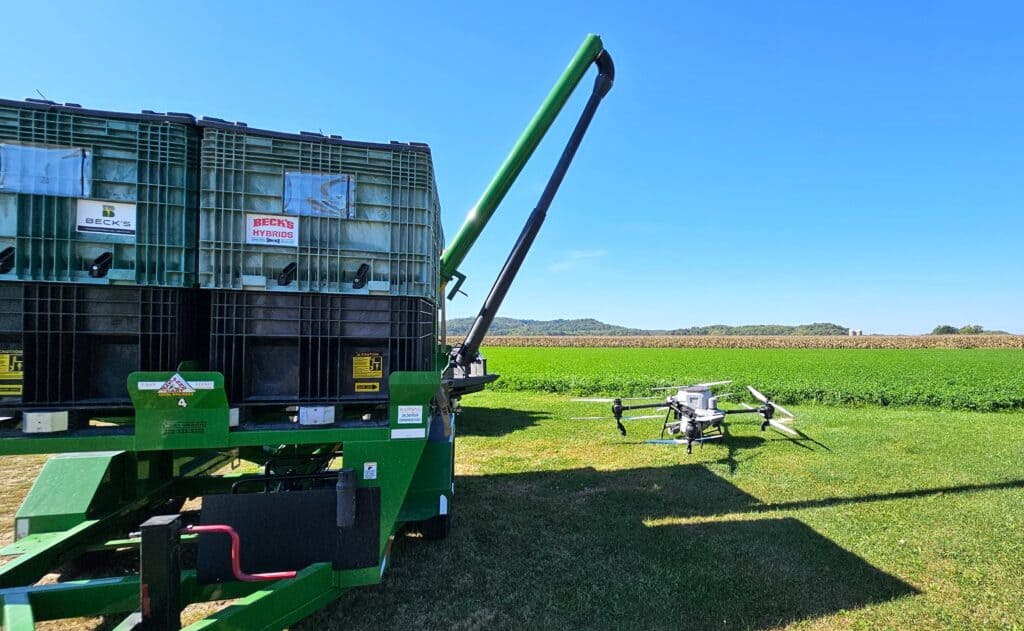
October 13, 2025
MARSHFIELD – Not only are drones becoming more widespread for enthusiasts, but Jeramy Williams, owner of American Drone in Marshfield, said the technology is helping Wisconsin farmers become more efficient and stay ahead of weather-related issues.
“It seems like every eight to 12 months, they are coming out with drones that are faster, more efficient and with better technology,” he said.
Though agricultural drones started appearing around 2015, Williams said they didn’t become widely useful for the average growers until the end of 2021.
The initial five or six years, he said, were mostly spent on development and research.
“Then in 2021, things changed,” he said. “Since then, they’ve been getting bigger and faster at an exponential scale. As drones get bigger and faster, they become more useful to more people. It’s a really exciting and kind of explosive industry right now.”
Serving as a drone dealer rather than manufacturer, Williams said American Drone helps connect growers with the right drone technology.
“We’ll also help somebody… do all the training,” he said. “At American Drone, we are more than a dealership – we are your year-round partner. We have a full-time sales and service staff, extensive spare parts inventory and factory-authorized warranty repair at our Marshfield location.”
Many advantages of application drone use
Williams said aerial application of inputs – such as fungicides, herbicides, insecticides, micronutrients and cover crops – can help mitigate crop damage caused by ground unit tires and have various other advantages.
“Think about it – with aerial applications, you don’t have a big tractor out in the field damaging crops,” he said. “If you have to apply a fungicide on corn, first and foremost, you’re not running any corn over [with a drone]. If you’re using a ground unit, you’re going to be running over about three bushels an acre, and with prices [for corn] the way they are, you can’t sacrifice anything.”
Williams said there is also no soil compaction with drone use.
“Obviously, the drone is above the crops compared to on the ground,” he said. “With the past few springs being fairly wet in the central part of the state, it doesn’t matter if the fields are saturated – drones fly about 12 feet above the crops, so the soil saturation doesn’t matter.”
Williams said the drones American Drone deals in are also completely autonomous.
“People aren’t having to fly [them using joysticks] or anything,” he said. “It knows exactly where it needs to go. It takes off by itself, flies out into the field, does its spraying or spreading and then returns to its home base. It needs to be very precise about where it is in the field so there is a good application. You’re only taking over if something goes wrong.”
Williams said drones offer a clear advantage over helicopters and planes when it comes to navigating varied terrain.
“In Wisconsin, a lot of fields have trees that surround the field,” he said. “With an airplane or helicopter, they have to pitch up to miss the trees on the edge of the field. When the application comes out of the drone, the wind that comes out pushes the product into the canopy, so you get better coverage.”
Furthermore, Williams said drones can help notify wildlife prior to the start of applications.
“Before applying to a field, we first have to fly the drone around the perimeter of the field so we know exactly what the perimeter should look like,” he said. “When we do that, you can literally see deer and other wildlife bolt from the field because they get scared – it works perfectly. It gives them a heads up with what’s to come.”
Sophisticated flying machines
The drones marketed by American Drone, Williams said, are far from ordinary recreational devices used for photography and similar purposes.
For example, the DJI Agras T100 – which is currently only available for preorder – Williams said, has unmatched performance, speed and versatility.
“It has a top speed of almost 45 miles per hour, has a maximum takeoff weight of 390 pounds and has a lift capacity of 220 pounds,” he said. “Additionally, it has a liquid payload of 26 gallons and a dry payload of almost 40 gallons. It has built-in 3D reconstruction mapping, so no extra drone is required.”
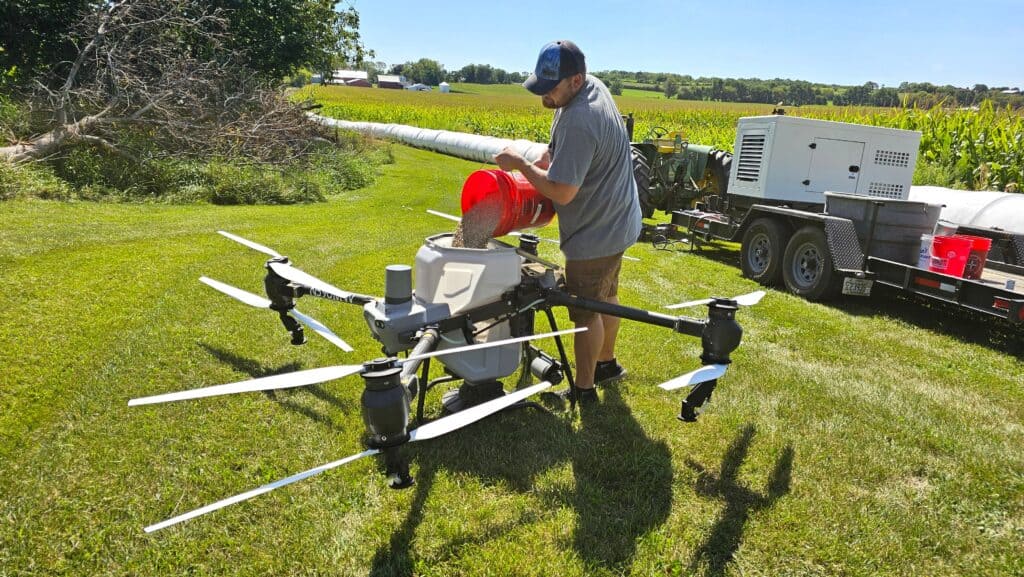
As for drone battery life, Williams said they last long enough to dispense a full load.
“If you’re spreading cover crop, seed, dry fertilizer or some kind of liquid pesticide, depending on what you’re spraying and what rate you’re spreading, that will dictate how long the drone is out in the field,” he said.
Typically, Williams said those applications take about six or seven minutes.
“After it’s done spreading, the drone comes back to its home base, and you reload it and put a new battery in,” he said. “You have three batteries – two are charging and one is flying. That way, you can cycle through three batteries all day long.”
As an example, Williams said the T60 application drone – which is a step below the T100 and can fly about 30 miles per hour – can cover about 450 acres of field a day.
“These drones can also swarm,” he said. “A pilot can legally fly three of these in the air at the same time, so they can break the field up into thirds – then you’re talking some big acres.”
Additionally, because some drones currently have a lift capacity of 220 pounds, Williams said they can come in handy for “heavy lifting.”
“If you have a large irrigation pivot and the gearbox goes out in the middle of a field, that gearbox can weigh up to 100 pounds,” he said. “Do you really want to hike a good distance out from the middle of a potato field? You can’t drive to the center of a potato field, so instead of carrying it out manually, it can be strapped to a drone.”
Williams said it would take two people about 10 minutes to switch a new gearbox in.
“Nobody had to fight the gearbox in and out and nobody had to twist an ankle or throw out their back,” he said.
Training included
As one might expect, to legally fly a drone for agricultural applications, Williams said users must be FAA (Federal Aviation Administration) approved.
“To fly those small camera drones, that’s one thing, but when it gets into these big heavyweights that weigh more than 300 pounds, there are lots of legality issues there,” he said. “Our customer care program helps [you navigate those] and helps you get training to understand how to use these drones safely.”
To stay up to date on the requirements, Williams said he works closely with the FAA.
“We build our webinars with the FAA directly, and then we post [them] on our website so people can listen directly from the FAA,” he said. “You don’t have to take the word of a dealer or distributor – you can hear it directly from the FAA.”
Williams said American Drone is committed to fostering a healthy drone industry, specifically in Wisconsin.
“We don’t want to be simply known as someone who just sells drones,” he said. “We’ve been doing this for the last four years, and people are loving it. Our mission statement is, ‘Our mission is your success.’ We want people to be successful, whether they’re just using our drones on their farm or they’re starting a small spray business.”
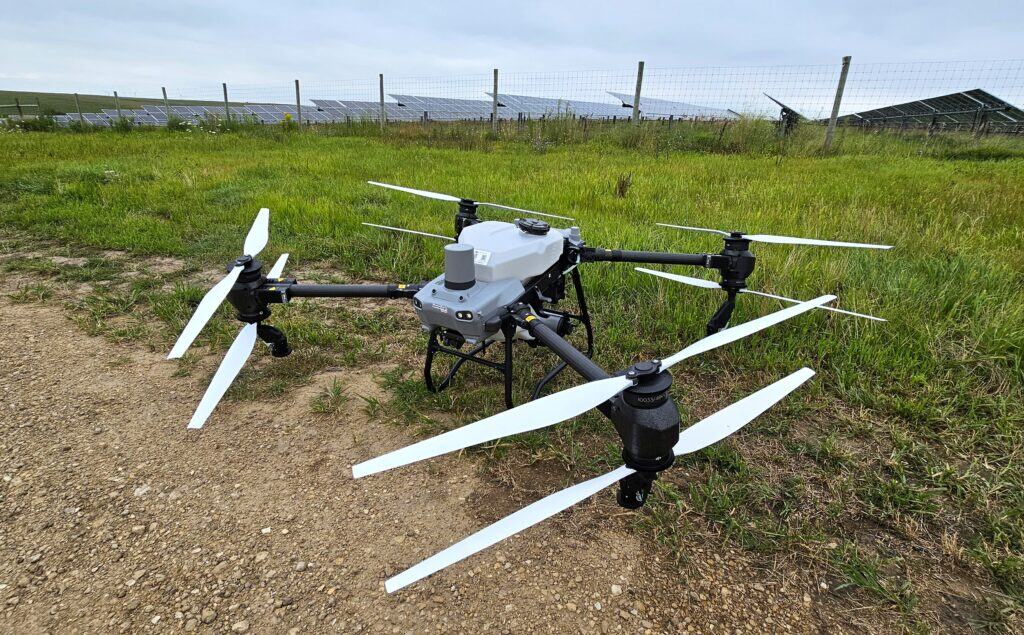
Williams said it goes unsaid that safety is of the utmost importance, especially with the financial investment of a sophisticated drone.
“First and foremost, it’s obviously about safety,” he said. “Also, we don’t want somebody to buy a $40,000 drone and crash it into the side of their silo – that doesn’t do you any good.”
Williams said American Drone instructors travel directly to clients anywhere in Wisconsin.
“Our instructors come to you for all that training on site, on your own property,” he said. “Because we do sell across the United States, if you’re located out of state, we have those customers come here for our training. Our training is very important, and I feel that’s something that separates us from other dealers.”
Types of users
Williams said American Drone serves a diverse range of clients beyond farmers looking to spray their fields.
The company, he said, provides services to several other industries as well.
“We even have fixed-wing crop dusters who are customers,” he said. “Why, you might ask? Airplanes are good for the great big, wide-open areas, but if you have fields that are tree-lined, drones are a great solution. The crop dusters are just adding other tools to their toolbox.”
The same can be said for customers who have ground rigs, Williams said.
“They’re already a custom applicator – they have a ground unit – and they’re adding drones as another tool,” he said. “Then you have the people who just want to start a new business. They buy a drone, go through the training and then start a custom application business solely with drones.”
Though not an expert in agriculture, Williams said he knows that timing can be everything when it comes to applying disease control treatments.
“If you need to get an application in a field immediately, with the use of a drone, you can decide exactly when you go out there,” he said. “The users are taking back the control of their applications on themselves and are not weather-dependent.”
Williams said golf courses, cranberry marshes and apple orchards are other examples of customers who use drone application services.
For more information, head to americandrone.us.
 Fincantieri Marinette Marine recognized for Green Marine certification
Fincantieri Marinette Marine recognized for Green Marine certification Wisconsin Manufacturing – rising confidence, workforce challenges, AI adoption
Wisconsin Manufacturing – rising confidence, workforce challenges, AI adoption


